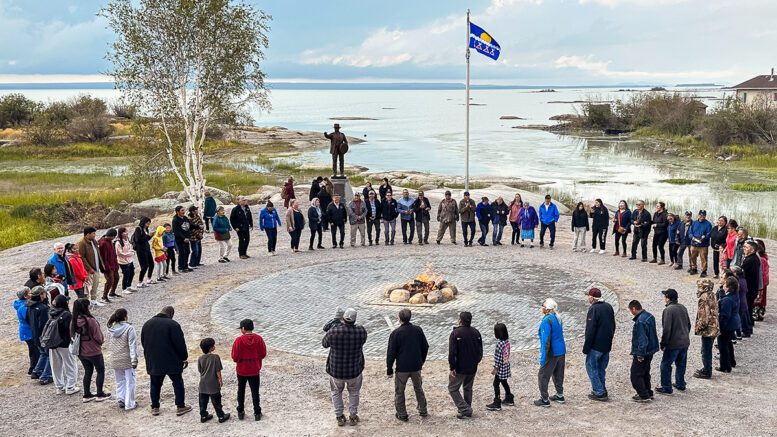The rain stopped, the clouds parted and sun shone brightly down on the bronze statue of legendary Chief Mǫwfi — revealed after years delays from a pandemic and then wildfires — to the delight of the assembled crowd.
A rainy and cool community of Behchokǫ̀ had set up tents and prepared for rain, but just before Friday’s ceremonies to both unveil the statue, mark 100 years of Treaty 11 and officially open a $14 million new cultural centre, the sun came out.
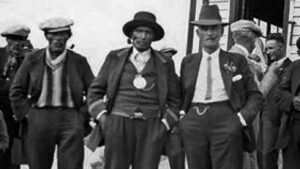
Chief Mǫwfi centre, pictured in 1934 at a wedding in Fort Rae, now Behchokǫ̀. (Photo courtesy of NWT Archives.)
Alfonz Nitsiza is Chief of Whatì.
“Mǫwfi is a father figure to so many of us, and many of us are directly descended from him,” he told the audience.
“We are all family working in unity for our people with our people. That is why for government, it is so important to have this memorial built so we will always have a reminder of who we are and why we do what we do.
“Every time we open our Tłı̨chǫ Agreement, we see his picture, and now we will have a constant reminder of the whole nation and others of his importance in our history.”
The first-ever bronze monument in Tłı̨chǫ region was designed by Darrell Chocolate, originally from Gamètì, who now resides in Yellowknife.
It shows Chief Mǫwfi wearing his treaty coat, treaty medal and pointed moccasins. Mǫwfi signed Treaty 11 on August 22, 1921.
The statue was created at Studio West Bronze Art Foundry in Cochrane, Alberta.
Jackson Lafferty is Grand Chief of the Tłı̨chǫ Government.
“It is in this spot that Mǫwfi’s father had his cabin that became an important focus point in early trading days,” he told the audience.

Tłı̨chǫ Government Grand Chief Jackson Lafferty speaks to the crowd Friday in Behchokǫ̀, with the statue of Chief Mǫwfi in the background. (James O’Connor/CKLB)
“It is here where our people decided how our land and water should be treated by the developers. It is here that our assembly has sat, including the first ever sitting of the Tłı̨chǫ assembly, when we first signed off the central government.
“It is in this place also that our first annual gathering was held in August 1992 an historical event, as we embark on the negotiation of a modern day treaty, the Tłı̨chǫ agreement.
“We are the owners, and in control, of our own land development, of our own programs and services today. We are able to practice a cultural way of life according to our own cultural values and rules.
“This statue of Mǫwfi is a lasting legacy, a symbolic of a new journey towards self government.”
During the negotiations, many concerns were raised, but Canada assured the people that they would not lose their right to hunt, fish and trap.
By the end of the summer, Chief Mǫwfi signed the Treaty at a ceremony in Behchoko.
At the time of signing, Chief Mǫwfi pronounced the words that guide us to this day:
“As long as the sun rises, the river flows, and the land does not move, we will not be restricted from our way of life.”
And while the new cultural centre and offices has been in use since last Christmas, they were officially welcomed into use with a ribbon cut by Elder Jimmy Rabeska and a community feast attended by hundreds.
Clifford Daniels is chief of Behchokǫ̀.
“It’s a big relief to finally get this building officially opened, and lots of people have contributed to, you know, having this building built, and it is a relief,” he said.
“We can do all the other activities that we weren’t able to do now, we do have a place in that, and I think it’s really a huge impact in the community for the coming years.”
NOTE: There are three commonly used spellings of the Chief’s name — Monfwi, Mǫwhì and Mǫwfi — with the latter being used at the statue dedication event.
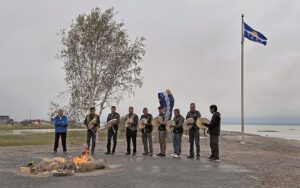
As drummers assembled to start ceremonies to unveil statue of Chief Mǫwfi in the background Friday in Behchokǫ̀, clouds were thick and rain had just stopped. (James O’Connor/CKLB)

The clouds thinned and the sun started to shine during the feeding the fire ceremony Friday in Behchokǫ̀. (James O’Connor/CKLB)
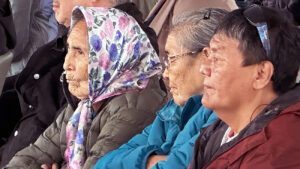
A few of the hundreds of people in the audience Friday in Behchokǫ̀, for the unveiling of a statue of Chief Mǫwfi. (James O’Connor/CKLB)
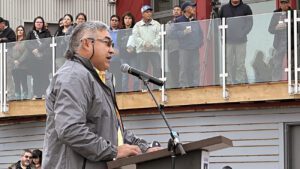
Behchokǫ̀ Chief Clifford Daniels speaks to the crowd Friday, as people line the upper deck of the new cultural centre. (James O’Connor/CKLB)
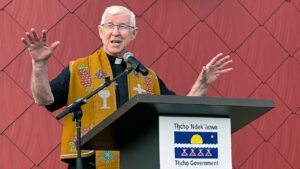
Father Gerald Fleming speaks to the crowd Friday in Behchokǫ̀ before blessing the new cultural centre. (James O’Connor/CKLB)

Father Gerald Fleming blesses the exterior of Behchokǫ̀’s new cultural centre on Friday. (James O’Connor/CKLB)
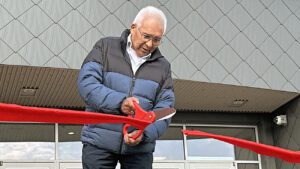
Elder Jimmy Rabeska was tasked with cutting the ceremonial ribbon on the new Cultural centre. (James O’Connor/CKLB)

Tłı̨chǫ Government flags adorn the main room in the new cultural centre in Behchokǫ̀ at the start of a community feast., (James O’Connor/CKLB)

Politicians all in a row, from left: NWT MP Michael McLeod; NWT Minister of Education, Culture and Employment Caitlin Cleveland; Yellowknife Mayor Rebecca Alty; and Monfwi MLA Jane Weyallon Armstrong pose for a photo after the ceremony Friday in Behchokǫ̀. (James O’Connor/CKLB)
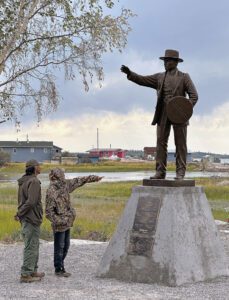
Finally unveiled on Friday, the statue of Chief Mǫwfi was a popular conversation piece hours later. (James O’Connor/CKLB)
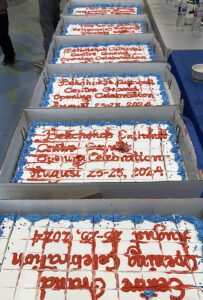
Let them eat cake! Hundreds of sweet squares for the hundreds gathered for the official opening of the new cultural centre in Behchokǫ̀. (James O’Connor/CKLB)
CORRECTION: Alphonz Nitsiza is a Tłı̨chǫ elder and chief of Whatì. Incorrect information was originally posted.

